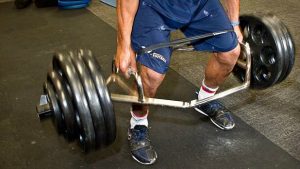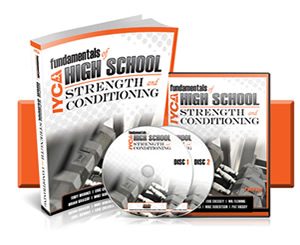I cringed and threw up in my mouth a little when he said it. “I know my girls are ready to play. We do thirty minutes of plyometrics at every practice, three days a week.” The earnest young volleyball coach went on to tell me he’d done his research and had “adapted” the program done by a certain university women’s volleyball program.
By adapted, he meant he threw away all the functional strength training, core training and stability-oriented training that laid the foundation for the plyometric work. He meant that he ignored the tissue quality, corrective exercise and active recovery work done by that university’s female volleyball players.
What he meant by “adapted” was that he took what was about 5-10% of a training program meant for year-round, single-sport athletes who were grown adults and made it essentially 100% of the training program. Thirty minutes of jump training, plyometrics and knee pounding fun and games.
At the start of every practice.
For 11-year-old girls.
The “old me” would have wanted to throat-punch this guy. I know that because the “new me” kind of wanted to as well…
But I took a deep breath and said: “tell me more.” And he did.
His description of his “program” gradually morphed into his complaints that his girls weren’t taking the program seriously. He knew that because of the number of ankle and knee injuries his team was suffering. “We do the plyos to prevent injury.”
In my head, I could hear myself saying, “no coach, you do the corrective exercise, core training and strength training to prevent injury. You do the plyometric training to improve athletic expression, hone context-specific athletic skills and improve explosive power.”
But hey, he did have a degree from the University of Search Engines…
So how do coaches and trainers go so wrong with the use of plyometrics in training programs? Good question! There are several key ways that we can hurt athletes with plyometrics. They are:
- Choosing inappropriate activities for the athletes in question
- Excessive volume
- A lack of foundational strength & power
Let’s look at these 3 areas, along with some simple remedies for “plyometric overdose:
1. Choose your weapons carefully – Choose appropriate activities to train plyometrics. There are a number of factors impacting selection. These include age, gender, developmental level, training age, sport, and overall training and practice load.
If you’re working with 6 – 8 year-olds, your best bet for a plyometric activity may be a simple quick step drill or a single-leg “hop around” activity. Working on low-level, static plyometric activities with your youngest clients can help them develop movement skills in the frontal plane as well as a degree of reactive “stiffness” in the ankle and knee.
Once established, this increased ability of connective tissues to receive stress, create stored potential energy and then release it will become a key element in overall increased force production.
For older athletes, carefully increase the intensity and complexity of the activities. Pay close attention to developmental levels and responsiveness to coaching. Progress from static quick steps to transitional quick step movements in the frontal or sagittal plane, allowing your athletes to learn how to manage reactive and responsive forces in small amounts first.
Try progressing your athletes to “2-to-1’s” as they exhibit mastery in lower level plyometric activities. This one is simple. Have your athlete start in an athletic stance and perform a ¼ to ½ squat followed by a moderate height/intensity jump. Landing on one foot, the athlete is directed to “stick and hold” the landing for 2-3 seconds. It’s easy to progress and very effective.
Progressions include the coach calling out the landing foot as the jump is initiated, jumps over a low hurdle, jumps in the frontal or transverse plane, and the addition of either a ball to catch or other secondary, low-degree-of-difficulty activity.
In what will undoubtedly be my “burn-him-at-the-stake” statement, I will say without hesitation that I never use Box Jumps with my clients. The Box Jump might be the least useful “plyometric” activity I can think of. If you want a great expression of high-speed hip flexion and panic-driven self-preservation, fine. But as an expression of plyometric power and ability, the Box Jump (at least as it is taught and used in most gyms and programs I’ve seen) is weak, at best, and dangerous/counter-productive at worst.
That being said, I’ve got a gym full of plyo boxes, so what now? Don’t jump ON the boxes. Instead, teach athletes how to decelerate and reactively explode coming OFF the boxes. Try these:
Stability Tempo Deceleration Jump – the athlete gets on a 12-18” box and “steps” off, landing on both feet. The goal is to decelerate the landing at a controlled and decreasing speed as the athlete nears the bottom of the squat position. So, moving slower as they get nearer the floor. Progress to single leg, lower to higher boxes as mastery is acquired.
Depth to Broad Jump – using the same start as above, the athlete explodes out of the bottom of the landing position into a broad jump. Progress to single leg, lower to higher boxes and jumps in the frontal plane.
Zercher-Loaded Seated Vertical Leap to Parallel Landing – Sit the athlete on a 18-24” box, holding a 10-30 lb slam ball or sandbag Zercher style. The athlete is instructed to drive through the heels and perform a vertical leap, minimizing forward lean during the takeoff process. Land into a parallel squat position.
If girls with minimal training exposure are the target audience, age and gender combine to influence activity selection. Q-angle in girls increases as girls enter, and pass through puberty. So girls in the 6 – 9 age group will likely exhibit less Q-angle related movement deviations than girls in older groups. Take what you observe, place it within the template of what we know and decide on activities accordingly.
2. Minimal effective dose – Contrary to one of the most popular (if largely unspoken) mantras in the fitness world, more is NOT better. In fact, when it comes to plyometric training, more is probably far worse than not enough, and certainly not as effective as just right.
So work on the Goldilocks concept – not too hot, not too cold, just right.
Plyometric activities should be dependent on the phosphagen, or ATP-PC energy system for fuel. So rep counts for most high-intensity plyo activities should be kept in the 3-8 range. If you need proof of that, watch an athlete perform an “A” skip over about 25 yards or so. Note the execution speed (rather than the speed across the ground) as the athlete gets into the 15-20 total rep range. You’ll notice the movement pattern change slightly and the execution speed of each rep begins to slow. What began as an effortless, flowing movement becomes more labored.
And yes, I’m aware that Olympic, pro and elite athletes may be exceptions to this rule. How many 10- or 15-year-old pro athletes are you training?
The “A” skip is a fairly low-level plyometric activity with a moderate level of pattern complexity. You can imagine how quickly the energy system, reactive pattern, and stabilization for a frontal plane single-leg hurdle hop might break down, right?
I’d much rather get 6 well-executed movements than 20 reps of gradually decreased proficiency due to system fatigue.
The other simple thing to remember is that, even when performed well, plyometrics are subject to plenty of multi-planar forces. They are, then, high-risk as well as high-reward.
So from the simple standpoint of risk mitigation, fewer, better-executed reps makes more sense than a pile of crappy ones.
Plyometrics are not conditioning activities. They are context-specific, skill development activities. Use them wisely and sparingly.
3. Foundation first – Possibly the most oft-committed sin of programming plyometrics is that of putting the skill before the foundation. Movement must dominate and strength levels must be adequate to deal with the increased ground reaction force. If you want your athletes to become great jumpers, weak legs just ain’t gonna cut it. It astonishes me how many coaches (sports or strength/performance) just don’t realize that. Let the intensity of your plyometric activities increase as the stability, strength, overall movement quality of your athletes rise. Without adequate stability and strength, the risk of injury from plyometric activities begins to outweigh the benefits. For most of my athletes, single leg stance is the first skill to master. It doesn’t sound like much, but SL stance is critical to the brain creating the proper recruitment patterns for knee stability. Younger athletes will struggle more with it, but you should be able to challenge your older athletes pretty early in your program. One of my favorite ways to connect stability patterns to movement is to connect a stability tempo exercise with a strength tempo lift, followed by a low rep plyometric activity. By using movement patterns with some overlapping neural pathways, we connect the stabilization patterns to the explosive ones, increasing quality and results overall.
jumpers, weak legs just ain’t gonna cut it. It astonishes me how many coaches (sports or strength/performance) just don’t realize that. Let the intensity of your plyometric activities increase as the stability, strength, overall movement quality of your athletes rise. Without adequate stability and strength, the risk of injury from plyometric activities begins to outweigh the benefits. For most of my athletes, single leg stance is the first skill to master. It doesn’t sound like much, but SL stance is critical to the brain creating the proper recruitment patterns for knee stability. Younger athletes will struggle more with it, but you should be able to challenge your older athletes pretty early in your program. One of my favorite ways to connect stability patterns to movement is to connect a stability tempo exercise with a strength tempo lift, followed by a low rep plyometric activity. By using movement patterns with some overlapping neural pathways, we connect the stabilization patterns to the explosive ones, increasing quality and results overall.
The bottom line is that without a foundation of strength, plyometrics are not only risky, but they’ll also never be as effective as possible.
Strength is king and every other athletic skill is subject to it.
Plyometric exercises are a great way to express and develop athletic power. I’ve suggested some ways to avoid the potential pitfalls of plyo training, and I hope this helps improve your programming.
In any case, let’s do less “adapting” and pay more attention to the details – and our athletes.
Keep the faith and keep after it!
 Bio: Coach Phil Hueston is not just another pretty trainer. With over 18 years of in-the-trenches experience with athletes ages 6 to 60, he brings a unique skill-set to the improvement of his athletes. The author of the Amazon best-seller “Alchemy; Where the Art and Science Collide in Youth Fitness,” his client list includes professional athletes, collegiate athletes as well as thousands of youth athletes. Phil has been the co-owner of All-Star Sports Academy in Toms River, NJ, one of the largest and most successful youth and family fitness centers in New Jersey since 2008. He was named “Coach of the Year” by the IYCA for 2012-2013. A contributor to IYCA.org and coach to other coaches, Phil provides unique insights and ideas that can help other coaches accelerate their clients’ progress and performance. Phil is married to the woman responsible for his entry into the fitness profession, MaryJo. Between them they have 2 grown children, Nate and Andrew, and 99 problems. Phil’s personal website is coachphilhueston.com, and he can be contacted at phil.hueston@hotmail.com
Bio: Coach Phil Hueston is not just another pretty trainer. With over 18 years of in-the-trenches experience with athletes ages 6 to 60, he brings a unique skill-set to the improvement of his athletes. The author of the Amazon best-seller “Alchemy; Where the Art and Science Collide in Youth Fitness,” his client list includes professional athletes, collegiate athletes as well as thousands of youth athletes. Phil has been the co-owner of All-Star Sports Academy in Toms River, NJ, one of the largest and most successful youth and family fitness centers in New Jersey since 2008. He was named “Coach of the Year” by the IYCA for 2012-2013. A contributor to IYCA.org and coach to other coaches, Phil provides unique insights and ideas that can help other coaches accelerate their clients’ progress and performance. Phil is married to the woman responsible for his entry into the fitness profession, MaryJo. Between them they have 2 grown children, Nate and Andrew, and 99 problems. Phil’s personal website is coachphilhueston.com, and he can be contacted at phil.hueston@hotmail.com
The IYCA High School Strength & Conditioning Specialist is the only certification created specifically for coaches training high school athletes. The course includes several hours of video instruction and two textbooks with contributions from some of the top strength and conditioning coaches in America. Click on the image below to learn more about how to become a certified high school strength & conditioning coach.


